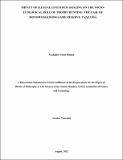| dc.description.abstract | Tanzania has set aside almost 40% of its land for conservation and trophy hunting is the main
activity conducted in an area covering about 80% of Tanzania’s conserved land. Trophy hunting
conserves wildlife inside and outside Protected Areas (PAs) and provides socio-economic
incentives for communities to conserve wildlife. Despite its importance, hunting companies
surrendered 45% of Tanzania’s hunting blocks to the government mainly due to habitat
destruction mediated by illegal livestock grazing. Unfortunately, there is no empirical
information on how illegal grazing affects trophy hunting. Therefore, the impact of illegal
grazing on the socio-ecological role of trophy hunting was examined using Moyowosi - Kigosi
Game Reserve (MKGR) as a case study. The study investigated whether the physical presence
of trophy hunting deters illegal grazing, improves wildlife habitats, and diversifies rural income.
Field experiments, laboratory work, questionnaires, and official records from MKGR were used
in this study. The study revealed that illegal grazing persisted in MKGR over three decades
(1990 – 2019). It destructed wildlife habitats, reduced forages, enhanced soil compaction,
increased human activities in the hunting blocks, and caused hunting blocks to lose their
economic viability. Also, there is a higher dietary overlap between buffalo and livestock,
buffalo density decreased in invaded areas and buffalo deployed spatial partitioning of about 5
km to avoid livestock. The study confirmed that indeed, trophy hunting plays an important
socio-ecological role within and outside protected areas. If affected, it will compromise the
multiple socio-economic benefits often gained by the local communities. The ecological role
of trophy hunting in conserving grass biomass and cover, enhancing soil infiltration and
penetration by preventing illegal grazing as observed in operational hunting blocks is also
apparent. The study recommends the MKGR address illegal grazing at the hotspot areas and
should conduct studies on areas outside the reserve that could be re-seeded with grass species
preferred by herders. The MKGR should establish awareness campaigns on the impact of illegal
grazing and develop a restoration plan to enhance soil nutrients, support herbaceous cover, and
diversify wildlife species to boost ecosystem functioning and prevent further deterioration of
this globally important Ramsar site in Tanzania. | en_US |

